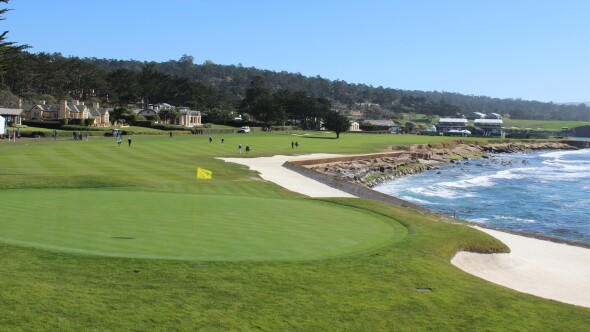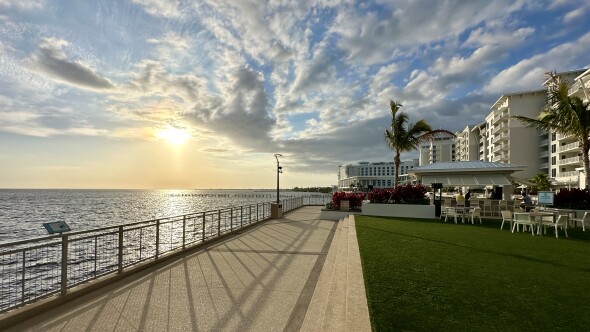Chambers Bay, this year's U.S. Open host, is being lauded as an examination closer to a British Open course than a typical U.S. Open track and with good reason:
The course, opened in 2006 and designed by Robert Trent Jones Jr., will promote a ground game unlike any previous U.S. Open. With fescue grass, just one tree on property and towering, sculpted dunes, it will appear more like Muirfield than the Olympic Club.
But is Chambers Bay really a "links golf course?"
The answer is as simple or as complicated as you want it to be. In my opinion, "links" is a spectrum with a whole lot of gray area.
In its vaguest, links is practically an acronym for "golf course." Example: "I had a great day on the links," said Steve, who played [swampy course in Florida]. Are you going to correct Steve? You could, but maybe wait until after he's started describing his third hole of the day in detail.
The most rigid definition of "links" can be traced to the book "True Links" by George Peper and Malcom Campbell. By their definition at the time of their 2010 publishing date, there were just 246 links courses, most of which are in the British Isles. Their terminology is based primarily on geography and geology.
**Update (6/16): Having said that, Northern Ireland's Rory McIlroy, an Open Champion himself, not only called Chambers Bay a "pure links" course in his U.S. Open news conference, but said "it plays more like a links than some links courses."
Between these two definitions, there are hundreds of courses with "links" in the title for reasons as simple as having large greens, pot bunkers or man-made dunes lining fairways grassed with tall fescue or other native grasses that make for a links appearance. Or a course with little to no trees on property will market itself as links-style. There are plenty of courses around Myrtle Beach, S.C. marketing themselves as links, and a lot of golfers who love the round, even if its links cred (at least in the eyes of architecture snobs) is questionable. Even architect Tom Doak, known for his critical examinations of golf courses and his expertise of British Isles links, built a links-inspired design in Myrtle Beach, the Heathland Course at Legends Golf & Resort.
I recall a round I played a couple years ago: The Gailes at Lakewood Shores in Michigan. Opened in the early 1990s, long before links had come en vogue, it was named a top 100 pick and one of the best links recreations in the world due to large double greens and fescue turf.
But ultimately, I was underwhelmed. Yes, the greens were neat, but the bentgrass layout played pretty sticky. The ball just didn't bounce around on fairways and around the greens like I expected. But Lakewood Shores is also one of the most popular buddies-trip destinations in northern Michigan, for a lot of blue-collar folks who will never make it overseas. It's a successful concept even as more and more 21st-century designs employ fescue grass to make the ground firmer.
A more famous example of a debatable "links" designation is U.S. Open venue Pebble Beach Golf Links, which even has "links" in the title. Sure, Pebble has many true oceanfront holes and the wind can howl. But it's a manicured resort course and the ball doesn't roll quite like the GB & I links.
So, back to our current specimen: Where is Chambers among links contenders and pretenders? Here are a few reasons stating the case for and against:
Why Chambers Bay is not a links course
Earth was moved. Lots of it. Reclaiming old quarry sites give architects a virtual clean slate to shape. The price tag to build was ultimately over $20 million. Has the Old Course at St. Andrews needed $20 million of work in the last 500 years?
It's really not on the coast. Puget Sound is a good 70-75 miles inland from the true west coast of Washington, and the site will be far less susceptible to erosion and change over time compared to Bandon Dunes or Pebble Beach. Wind is also not as much of a factor, as locals admit there are more days in the 5-10 mph range than 15-20 mph.
The size of the course is anything but traditional: one of the great joys about traditional links golf is that tees and greens are generally close together and with most golfers playing the member tees, rounds under three and a half hours are the norm. The USGA is planning on rounds at Chambers Bay taking 10-12 minutes longer than usual thanks to the estimated seven-and-a-half-mile walk. And I would wager that's an optimistic prediction once the competition is underway and some rulings issues begin surfacing.
Video: Matt Ginella on Chambers Bay design
Arguments for declaring Chambers Bay a links course
Most simply: Chambers Bay is a golf course on sandy soil next to saltwater seeded with fescue grass. The 10th hole, which is one of the most old world links-looking holes, was left virtually untouched by Jones Jr. and is probably the most authentic links hole on the course.
Should "links" be defined as philosophy or geography? Any course that's firm and fast, promoting a ground game sure feels linksy, even if the ocean is 500 miles away. A lot of Texas golf courses in the summertime or fall, on baked out Bermuda fairways with a stiff breeze, feel awfully linksy to me.
Maybe defining "links" should begin with how the ball acts on the ground and not with geography itself.
Some "true links," especially modern ones, still require the need for a bulldozer. Soil and seed, bulldozers and shapers are grading and prepping land for irrigation, cart paths and other facilities. In fact, a good chunk of British Isles links were bulldozed in World War II for the military and later recreated, including Turnberry's Ailsa Course. Kingsbarns, considered by many to be one of the top 10 courses in the world, made use of a shaper to achieve its three-tiered amphitheater effect that gives 18 holes sea views.
Lastly, let's remember that golf didn't begin on sandy dunes in St. Andrews because it was ideal for the new game, but mostly because the land was next to town with little use for farming or building. Golf design is at its best when a great course is built on otherwise useless or used-up land, and that may ultimately be what's remembered most about Chambers Bay.


















The original use of links referred to the location. It was land along a coast that "linked" the ocean to the mainland.
I'd call it more of a Jinks not Links. I like Jones courses, but this venue it a project gone bad that's the only way I would describe it.